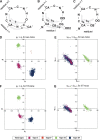Mimicry by asx- and ST-turns of the four main types of beta-turn in proteins
- PMID: 15459339
- PMCID: PMC2286581
- DOI: 10.1110/ps.04920904
Mimicry by asx- and ST-turns of the four main types of beta-turn in proteins
Abstract
Hydrogen-bonded beta-turns in proteins occur in four categories: type I (the most common), type II, type II', and type I'. Asx-turns resemble beta-turns, in that both have an NH. . .OC hydrogen bond forming a ring of 10 atoms. Serine and threonine side chains also commonly form hydrogen-bonded turns, here called ST-turns. Asx-turns and ST-turns can be categorized into four classes, based on side chain rotamers and the conformation of the central turn residue, which are geometrically equivalent to the four types of beta-turns. We propose asx- and ST-turns be named using the type I, II, I', and II' beta-turn nomenclature. Using this, the frequency of occurrence of both asx- and ST-turns is: type II' > type I > type II > type I', whereas for beta-turns it is type I > type II > type I' > type II'. Almost all type II asx-turns occur as a recently described three residue feature named an asx-nest.
Figures

Similar articles
-
Redesigning the type II' β-turn in green fluorescent protein to type I': implications for folding kinetics and stability.Proteins. 2014 Oct;82(10):2812-22. doi: 10.1002/prot.24644. Epub 2014 Jul 31. Proteins. 2014. PMID: 25044033
-
Characterization of beta-turn and Asx-turns mimicry in a model peptide: stabilization via C--H . . . O interaction.Biopolymers. 2006 Apr 15;81(6):440-9. doi: 10.1002/bip.20441. Biopolymers. 2006. PMID: 16411188
-
A recurring two-hydrogen-bond motif incorporating a serine or threonine residue is found both at alpha-helical N termini and in other situations.J Mol Biol. 1999 Mar 12;286(5):1651-62. doi: 10.1006/jmbi.1999.2551. J Mol Biol. 1999. PMID: 10064721
-
Intramolecular backbone···backbone hydrogen bonds in polypeptide conformations. The other way around: ɛ-turn.Biopolymers. 2017 Jan;108(1). doi: 10.1002/bip.22911. Biopolymers. 2017. PMID: 27404945 Review.
-
[A turning point in the knowledge of the structure-function-activity relations of elastin].J Soc Biol. 2001;195(2):181-93. J Soc Biol. 2001. PMID: 11727705 Review. French.
Cited by
-
MTH1 Substrate Recognition--An Example of Specific Promiscuity.PLoS One. 2016 Mar 21;11(3):e0151154. doi: 10.1371/journal.pone.0151154. eCollection 2016. PLoS One. 2016. PMID: 26999531 Free PMC article.
-
Multiple substitutions lead to increased loop flexibility and expanded specificity in Acinetobacter baumannii carbapenemase OXA-239.Biochem J. 2018 Jan 11;475(1):273-288. doi: 10.1042/BCJ20170702. Biochem J. 2018. PMID: 29229762 Free PMC article.
-
Structure of the MutLα C-terminal domain reveals how Mlh1 contributes to Pms1 endonuclease site.Nat Struct Mol Biol. 2013 Apr;20(4):461-8. doi: 10.1038/nsmb.2511. Epub 2013 Feb 24. Nat Struct Mol Biol. 2013. PMID: 23435383
-
The active site of the SGNH hydrolase-like fold proteins: Nucleophile-oxyanion (Nuc-Oxy) and Acid-Base zones.Curr Res Struct Biol. 2023 Dec 29;7:100123. doi: 10.1016/j.crstbi.2023.100123. eCollection 2024. Curr Res Struct Biol. 2023. PMID: 38235349 Free PMC article.
-
X-ray structure of the mature ectodomain of phogrin.J Struct Funct Genomics. 2015 Mar;16(1):1-9. doi: 10.1007/s10969-014-9191-0. Epub 2014 Nov 26. J Struct Funct Genomics. 2015. PMID: 25421040
References
-
- Baker, E.N. and Hubbard, R.E. 1984. Hydrogen bonding in globular proteins. Prog. Biophys. Mol. Biol. 44 97–179. - PubMed
-
- Bordo, D. and Argos, P. 1994. The role of side-chain hydrogen bonds in the formation and stabilization of secondary structures in soluble proteins. J. Mol. Biol. 243 504–519. - PubMed
-
- Chakrabarti, P. and Pal, D. 2001. The inter-relationships of side-chain and main-chain conformations in proteins. Prog. Biophys. Mol. Biol. 76 1–102. - PubMed
MeSH terms
Substances
LinkOut - more resources
Full Text Sources

